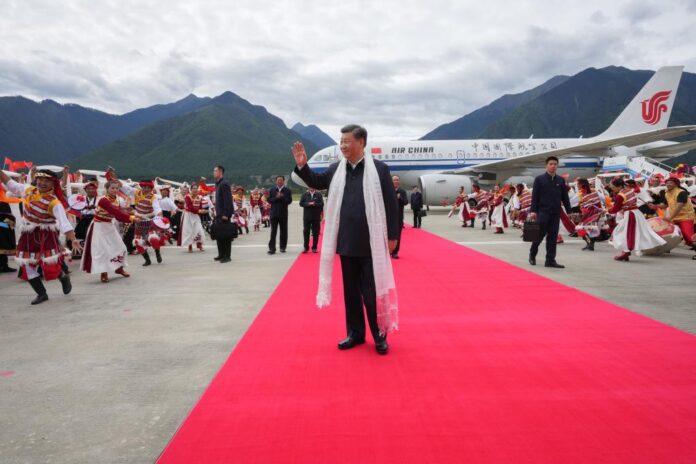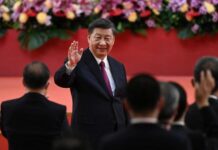(TibetanReview.net, Jul23’21) – Chinese President Xi Jinping has visited Tibet Autonomous Region (TAR), which makes up roughly the western half of historical Tibet, over Jul 21-22 without any prior media report, leaving observers and analysts to draw a range of conclusions about its significance and implications. Xi previously visited the TAR on Jul 21, 2011, when he was the country’s Vice President, to lead a delegation to mark the “60th Anniversary of the Peaceful Liberation of Tibet”.
China’s official Xinhua news agency said Jul 23 that Xi flew into the city of Nyingchi (Tibetan: Nyingtri) on Jul 21 and took a train to the capital Lhasa the following day.
He was said to have been accompanied by Zhang Youxia, a vice chairman of China’s Central Military Commission and a senior general in the People’s Liberation Army.
According to the scmp.com Jul 23, Xi was leading a delegation to mark the 70th anniversary of the founding of the administrative and religious capital of the Tibet autonomous region. China’s official news.cgtn.com simply said Jul 23 that Xi’s visit came as TAR celebrated its 70th anniversary of “peaceful liberation”.
In video footage shared on Chinese social media, Xi was seen greeting residents in Nyingchi – known as the Switzerland of Tibet – with the Tibetan expression for good luck “Tashi Delek” and calling on them to have faith in a better future, the scmp.com report noted.
***
On landing at Nyingchi Mainling Airport on Jul 21 Xi was welcomed by local residents and officials of various ethnic groups. He then visited the Nyang River Bridge to inspect ecological preservation in the basin of the Yarlung Zangbo River and its tributary Nyang River.
In the afternoon, he visited an urban planning center, a village and a park to learn about urban development planning, rural revitalization, urban park construction and other work.
The next day, he went to Nyingchi Railway Station and inspected the overall planning of the Sichuan-Tibet Railway and the construction and operation of the Lhasa-Nyingchi section. He then took a train to Lhasa, the capital of Tibet, said China’s official media reports.
Xi’s visit to Lhasa was described as an inspection tour. The Xinhua report said he visited the Drepung Monastery, Barkhor Street and the Potala Palace square to learn about the work on ethnic and religious affairs, the conservation of the ancient city, as well as the inheritance and protection of Tibetan culture. It said he also chatted with local residents.
***
China’s official globaltimes.cn Jul 23 cited Chinese analysts as saying Xi’s visit showed the central government’s emphasis on boosting the economic growth and stability of TAR as well as improving local residents’ livelihoods in the next round of development.
“China has listed the development of border areas in the next five-year plan, and reducing the gap between western and eastern areas is also an important goal to be achieved marching toward the second centenary goal,” Lou Chunhao, deputy director of the Institute of South Asian Studies at the China Institutes of Contemporary International Relations, was quoted as saying.
Referring to the Sichuan-Tibet Railway, whose sections within Tibet and within China are already operational but whose middle section – Ya’an-Nyingchi section – began to be built only in Nov 2020, the report said the project will boost the region’s economic development and even generate an economic radiation effect to neighbouring countries.
“As infrastructure connectivity improves, Tibet could also be built into a frontier of opening-up in Southwest China. For example, Tibet could facilitate trade and economic cooperation with Nepal,” Lou was quoted as saying.
He has said Tibet’s deep integration into the national rail will enable efficient transportation of bulk of goods and cargos in and out of the region.
The report noted that China’s National Development and Reform Commission, the country’s economic planner, had listed promoting the construction of the Sichuan-Tibet railway as a key project in the nation’s railway development.
Xi had previously called for a speedy and qualitative construction of the Sichuan-Tibet railway, emphasizing its strategic importance.
***
Indian media reports highlighted the strategic significance of China’s ongoing key projects in Tibet located close to India’s border areas underpinned by Xi’s visit.
Xi’s visit to the border region and Nyingchi assumes particular significance coming a month after China started operating the first bullet train line in Tibet, linking Lhasa to Nyingchi near the border with Arunachal Pradesh, said thehindu.com Jul 23.
It said the Lhasa-Nyingchi rail was one among several major infrastructure projects recently completed in Tibet’s southern and southeastern counties near the Arunachal border.
Last month, China completed construction of a strategically significant highway through the Grand Canyon of the Yarlung Zangbo river, the “second significant passageway” to Medog county that borders Arunachal Pradesh state of India.
The report noted that the strategic Lhasa-Nyingchi rail was deemed important enough for President Xi to officially launch it and to describe it as “a major step in safeguarding national unity and a significant move in promoting economic and social development of the western region.”






